In the beginning of 2016, I introduced my patients to my colleague, Chris Montgomery, who would be taking over my caseload, packed my bags and soon after left Edmonton. After flying half way around the world, I landed in Kathmandu, Nepal, and ate my first of many dal bhat meals. I had signed on to a four-month position as a Physiotherapist Trainer for the International Organization for Migration (IOM), seconded by AmeriCares, at a rehab centre called the Injury Rehabilitation Unit (IRU) in the small centre of Chautara, Sindupalchowk.

Credit: http://news.bbc.co.uk/2/hi/south_asia/4937496.stm
Many of you have probably heard about the devastating 7.8 magnitude earthquake that occurred in Nepal in April of 2015 and the intense aftershocks that followed, including a 7.3 magnitude aftershock in May of 2015. The destructive earthquakes left more than 21,000 people injured and many required surgery and subsequent physiotherapy. On top of this, over 473,000 homes were destroyed and hundreds of thousands of other homes were deemed unsafe to live in afterward.
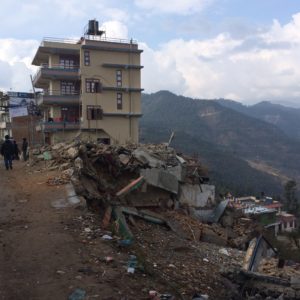
What was formerly a house was reduced to rubble after the 2015 earthquake in Chautara, Sindupalchowk, Nepal
Physiotherapy services as we know them in Alberta, Canada are very different than in Nepal. Organizations such as Handicap International, that employ physiotherapists, have been advocating to increase the number of physiotherapists working in hospitals for the government for years. Whereas we are fortunate often to have one physiotherapist for each unit in the hospitals in Edmonton, a physiotherapist in Nepal often will be responsible for a much larger number of patients and he or she might be hired by a non-governmental organization as opposed to the government.
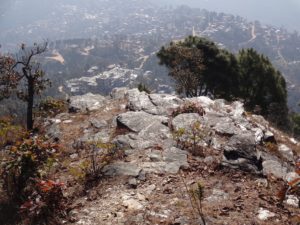
Aerial view of Chautara and the Sindupalchowk district hospital (centre left) from an adjacent mountain
After the 2015 earthquake, the IOM saw a need for intensive rehabilitation services after an extensive mapping and needs assessment was carried out. It was realized that, since people that had sustained traumatic injuries such as fractures and neurological injuries had limited function and mobility, they wouldn’t be able to successfully return to their work or their homes and this would ultimately create a migration issue. The IOM quickly responded to this need by designing, through extensive consultation, the IRU in Chautara, which was an interdisciplinary, intensive in-patient rehabilitation centre with a 20 patient bed and 14 caregiver bed capacity. The interdisciplinary team consisted of a health focal point, three physiotherapists, two physiotherapist trainers, five nurses, a psychosocial counselor, a facility manager with a nursing background, a medical officer, doctors from the local hospital and a social worker and paramedic who made up the community outreach team. My role as the second physiotherapist trainer was to build capacity within the physiotherapy team while bringing my knowledge and experience gained through working in private practice orthopaedics and acute care settings to help increase efficiency within the centre.

The IRU (the white tents) nestled amongst the local farms
When I arrived in Nepal, it had already been eight months since the major earthquake struck. In our setting at Pivotal, patients who have sustained fractures usually attend physiotherapy soon after they are referred by their surgeons or specialists for physiotherapy and this generally happens within one to two months after their injuries. Initially, I was wondering how patients would respond to physiotherapy with such a large gap in time between their injuries and their physiotherapy treatment. I was relieved and reminded of the power of physiotherapy after I started to see the significant functional improvements that the patients were making within the first few weeks of my term.
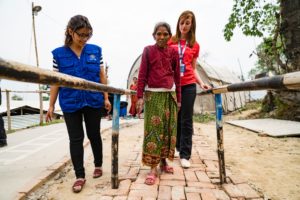
Credit: William Vazquez/AmeriCares
Working with a patient in the outdoor parallel bars
One of the patients that improved the most was a young man who attended rehab with his niece. The young girl, who was in her home when the earthquake struck, was rescued by her uncle who ran in to save her. However, the young man ruptured his ACL in the process. Both of them improved to near baseline and were sent home with functional exercise programs to allow them to improve further after their intensive rehabilitation at the IRU. The young man ended up becoming our “hero” patient and even led group exercise classes.
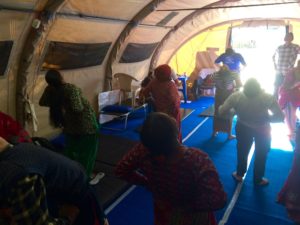
Group yoga class being led by one of the physiotherapists
A typical day for patients:
- waking up early, and eating breakfast together
- participating in group yoga class
- completing individual exercises and receiving manual therapy treatment and exercise progressions from the physiotherapists
- participating in group lower and upper extremity exercise classes
- having lunch together
- participating in health education classes taught by the nurses
- completing more exercises
- drinking afternoon tea or lassi together
- completing more exercises
- sometimes an evening walk
- eating supper together
- getting ready for bed, sleeping and starting it all over again the next day.
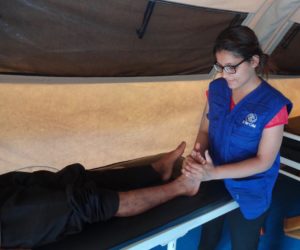
Manual therapy being performed by a physiotherapist on a patient
Patients were expected to exercise for at least four to five hours per day, which made the IRU unique in many ways. It might be hard for some of our patients who attend physiotherapy sessions to imagine doing physiotherapy for the better part of the day at the clinic! The end result of all the hard work and energy the patients at the IRU put into their rehab programs was improved function, and in many cases, the ability to successfully return to work and hence generate an income that would allow them to support their families. As an added benefit in the intensive rehab centre, the patients saw each other improving and through peer support, they made further gains in their recoveries. It was often difficult to say goodbye to the patients when they “graduated” from their rehab programs.
I would like to thank the Pivotal staff for their support that allowed me to contribute to the growth of the physiotherapy profession while working in another part of the world. I would also like to thank all of the staff at IOM and the IRU for their support while I was working in Nepal.
Best wishes,
Jennifer Allen MScPT
Physiotherapist
